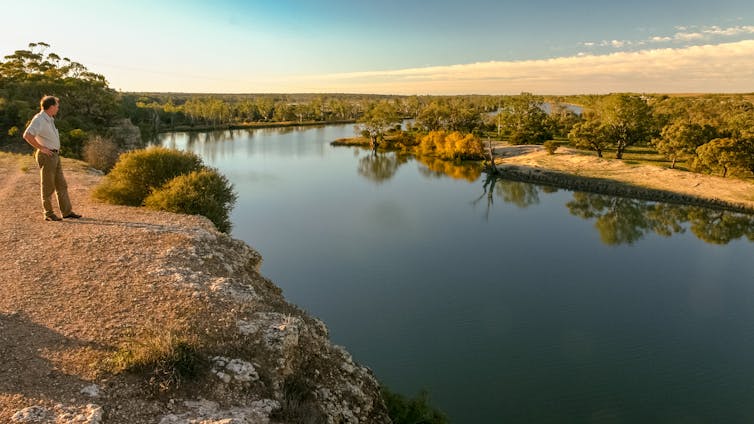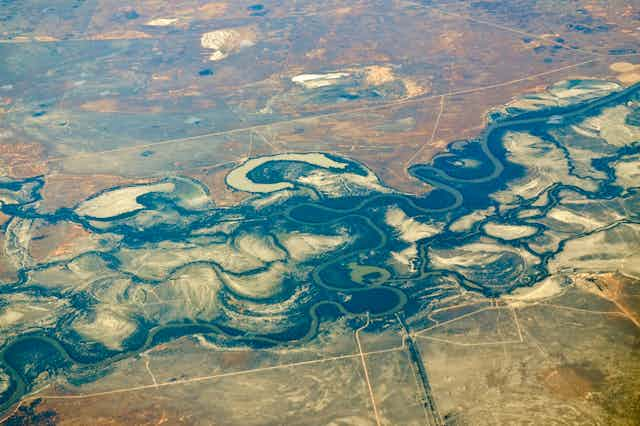The Murray Darling Basin Plan is an historic deal between state and federal governments to save Australia’s most important river system. The A$13 billion plan, inked over a decade ago, was supposed to rein in the water extracted by farmers and communities, and make sure the environment got the water it needed.
But now, less than a year out from the plan’s deadline, it’s in a dreadful mess. Projects have not been delivered. Governments cannot agree on who gets the water, or how. All the while, water in the Murray-Darling Basin will become scarcer as climate change worsens.
The Albanese government was elected on a promise to uphold the Murray-Darling Basin Plan. But earlier this month, Environment and Water Minister Tanya Plibersek conceded the plan is “too far behind” and needs a “course correction”.
I have studied and promoted sustainability measures in the Murray-Darling Basin for 35 years. Here, I outline the five steps needed now to ensure the health of the river system and the people who depend on it.

A refresher: what is the Murray-Darling Basin Plan?
The Murray-Darling Basin covers about a seventh of the Australian land mass: most of New South Wales, parts of Queensland, South Australia and Victoria, and all of the Australian Capital Territory. It includes the Murray River and Darling River/Baarka and their tributaries.
These lands and waters are the traditional lands of more than 40 Indigenous nations. Around 5% of the basin consists of floodplain forests, lakes, rivers and other wetland habitats. Vast amounts of water are extracted from the rivers to supply around three million Australians, including irrigating farms.
The Murray-Darling Basin Plan became law in 2012, under the Labor government. It is due to be fully implemented and audited by the end of June 2024.
The plan limits the amount of water extracted from the basin. It aims to both improve the condition of freshwater ecosystems and maintain the social and economic benefits of irrigated agriculture.
Under the plan, 3,200 billion litres a year would be returned to rivers – about 14% of total surface water in the basin.
The water was largely to be recovered by buying back water entitlements from farmers. Some 450 billion litres would be retrieved through water efficiency projects.
The plan has twice been amended to reduce the amount of water taken from farmers. The first change, made on questionable grounds, reduced the water recovery target by 70 billion litres a year. The second reduced it by 605 billion litres, with the water to instead be recovered through 36 water-saving offset projects.
Further, the Victorian and NSW governments committed to reaching agreements with farmers to enable water for the environment to safely spill out of river channels and across privately owned floodplains, to replenish more wetlands.
Read more: Australia has an ugly legacy of denying water rights to Aboriginal people. Not much has changed

So how’s the plan going?
Things are not going well. As of November last year, the offset projects were likely to deliver between 290 and 415 billion litres of the 605 billion litres required. And very little water is getting to floodplains.
And of the 450 billion litres to be retrieved through water-efficiency projects, only 26 billion litres has been recovered.
It means of the 3,200 billion litres of water a year to be returned to the environment, only 2,100 billion litres was being achieved as of March this year – plus the small amount of projected water from offset projects, if it’s delivered.
At a meeting in February this year, the nation’s water ministers failed to agree on how to meet the plan’s deadline.
As governments quibble, the rivers and floodplains of the Murray-Darling suffer. In the past decade, millions of fish have perished in mass die-offs. Toxic algae has bloomed, wildife and waterbirds have declined in numbers and wetlands have dried up. These are all signs that too much water is still being taken from the system.
So how do we get the basin plan back on track? Below, I identify the top five priorities.

1. NSW must get its act together on water plans
Integral to implementing the broader basin plan are 33 “water resource plans” devised by the states. These plans bring the basin plan into legal force and detail how much water can be taken from the system and how it is divided between users such as farmers, communities and the environment.
NSW must produce 20 plans. To date, just five are in place. At least seven plans by NSW were recently withdrawn to be re-drafted.
Until they’re finalised, key measures of the basin plan cannot be implemented. The new NSW Minns government must prioritise the remaining water resource plans and have them accredited by the Commonwealth government.
2. Federal water buybacks must ramp up
The Albanese government is taking steps to improve water recovery under the plan, such as consulting stakeholders and restarting water buybacks. But it must do more.
Both NSW and Victoria will almost certainly miss the 2024 deadline for delivering all infrastructure projects they promised to offset 605 billion litres of water.
The federal government is legally obliged to – and should – purchase additional water from farmers to cover any gap. It must also acquire more than 400 billion litres of water to make up for the shortfall in water efficiency projects.
For this to occur, a Coalition-era cap must be lifted from 1,500 billion litres to enable more federal government water purchases from farmers.

3. Abandon questionable water-saving projects
At least six water-saving projects look unlikely to meet the deadline.
They include a large project proposed by the former NSW government to reduce evaporation at Menindee Lakes, which appears doomed.
Another project at Yanco Creek in NSW has also fallen behind, and four of the nine Victorian projects have been paused.
What’s more, the ecological merit of these projects are contested – as is the scientific rigour of the proposed auditing method. These projects should be abandoned in favour of reconnecting rivers to their floodplain.
4. Reconnect rivers and floodplains
For floodplain wetlands to function, they must be regularly inundated with water. To date, just 2% of these parts of the basin are inundated each year by managed flows (or in other words, intentional water releases by authorities).
The federal government holds water for this purpose. Delivering the water requires compensation for the owners of inundated properties, as well as upgraded roads, bridges and levee banks. Managed inundation can benefit landholders, such as by reducing the impacts of natural floods. But governments must do a better job of communicating these benefits to win support.
The federal government needs NSW and Victoria to help implement their agreement for watering floodplains, but this cooperation has been extremely slow.

5. Make information transparent
The data and modelling used to manage water in the basin is complex and is often not publicly available.
In its final report in 2019, a South Australian royal commission into the Murray-Darling Basin was highly critical of the Murray-Darling Basin Authority. The report found the authority failed to act on “the best available science” when determining how much water could be returned to the environment, and withheld modelling and other information that should have been made public.
Making such information freely available is crucial for accountability and to build public trust.
Time for tough decisions
Each key element of the basin plan has encountered trouble at the implementation stage. The five steps I’ve outlined are essential to rectifying this.
Attention must now also turn to a review of the Murray-Darling Basin Plan, which is legally required in 2026. As well as addressing the problems detailed above, it must address two big issues essentially ignored in the plan to date: the lack of Indigenous rights over water, and water losses due to global warming and other environmental change.
If the Albanese government is to uphold its election promise to deliver the plan, hard decisions – and trade-offs – will be required.

